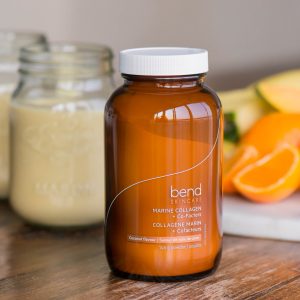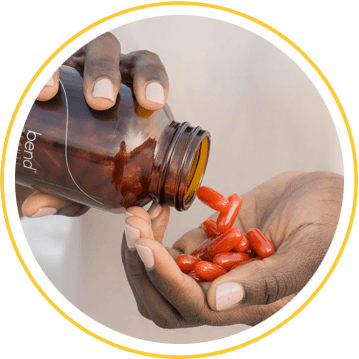
Key Takeways:
- Our products have Health Canada-authorized claims
- Our products include Co-Factors (high quality, whole food sourced vitamin C and silicon) that help with collagen cross linking, improving collagen formation
- We recently conducted a screening Life Cycle Assessment of our Marine Collagen + Co-Factors and purchased carbon offsets to address the carbon footprint from our products
- Hydrolyzed marine collagen has less impact on the environment than bovine
Collagen has been all the rage in the beauty and skincare industries for some time now, and we get why! The benefits of ingesting collagen are plentiful. With so many collagen products on the market to choose from, we want you to understand why our Marine Collagen + Co-Factors is the best option to choose for your daily dose.
Evidence-based, Health Canada Authorized Claims
We have Health Canada authorized claims behind our Marine Collagen + Co-Factors products. They are:
- Helps in collagen formation
- Helps to maintain healthy hair, skin and nails
- Source of an antioxidant that helps protect against free radicals
- Helps in wound healing
According to the Health Canada website, the Natural and Non-Prescription Health Product Directorate assesses whether health claims are truthful and not misleading with a review process all of our products have been subject to. This means you can be confident knowing our products do what they say they’re going to do, and the claims have been substantiated by research and a governing body.
Formulated with Co-Factors
Our Marine Collagen + Co-Factors is formulated with high-quality vitamin C and silicon, naturally sourced from acerola fruit and bamboo, respectively. Both of these nutrients are necessary for a process called collagen cross-linking. This process improves collagen strength, function, and makes it more resistant to damage.
We chose to include vitamin C from acerola fruit in Marine Collagen + Co-Factors, because it’s one of the best sources of vitamin C for inclusion in dietary supplements. Acerola (Malpighia glabra) fruit is found throughout Central America and northern parts of South America.
Silicon (not to be confused with silicone), is the second most abundant element on Earth, and the third most abundant trace element in our bodies (1). Within our bodies, connective tissues contain the highest silicon content. Silicon is present in hair, nails, the outer layer of the skin called the epidermis, and the hair cuticle (2). Higher silicon content in hair results in lower rates of hair loss and increased brightness. Nails are also affected by the presence of silicon, since this is the predominant mineral within nails. In fact, soft and brittle nails can indicate a silicon deficiency (1).
The addition of these Co-Factors in our products is key for ensuring you will build healthy, strong collagen and improve the health of your hair, skin and nails.
Sustainability
Sustainable beauty is at the core of who we are as a brand. We recently completed a screening Life Cycle Assessment (LCA) of Marine Collagen + Co-Factors to understand its carbon impact. This work provided us with reliable, science-based information about the product’s carbon footprint. To address this carbon footprint from our products we have purchased carbon offsets from Carbon Fund. In addition, we source our hydrolyzed marine collagen from sustainably-caught wild fish. Choosing our products is choosing a sustainably sourced, environmentally responsible brand.
Marine Over Bovine
In addition to the above, we chose hydrolyzed marine collagen over bovine collagen in our Marine Collagen + Co-Factors products for several reasons. Wild-caught fish are not treated with drugs, such as antibiotics, or hormones that may be used in farming practices, depending on local regulations. The skins used to manufacture our hydrolyzed collagen are by-products from the food industry from fisheries under strict government control regarding catch methods and quotas. Currently, although cow hides are abundant byproducts and cheap to produce, their source plays an important negative role in climate change. Livestock production accounts for 14.5 percent of all human-induced green-house gas emissions with beef and bovine milk production contributing 41 and 19 percent of those emissions (4); that includes grass-fed as well as grain-fed animals.
In sum, we are proud of our Marine Collagen + Co-Factors products and we believe they are the best choice to incorporate a daily dose of collagen into your routine for the reasons outlined above. Click here to shop Marine Collagen + Co-Factors.
References:
- Araújo LA, Addor F, Campos PM. Use of silicon for skin and hair care: an approach of chemical forms available and efficacy. An Bras Dermatol. 2016 May-Jun;91(3):331-5.
- Jurkić LM, Cepanec I, Pavelić SK, Pavelić K. Biological and therapeutic effects of ortho-silicic acid and some ortho-silicic acid-releasing compounds: New perspectives for therapy. Nutr Metab (Lond). 2013 Jan 8;10(1):2.
- Sripriya R, Kumar R. A Novel Enzymatic Method for Preparation and Characterization of Collagen Film from Swim Bladder of Fish Rohu (Labeo rohita). Food and Nutrition Sciences 2015;6(15): Article ID:61421,11 pages 10.4236/fns.2015.615151 Accessed online on September 23, 2021 at http://file.scirp.org/Html/13-2701752_61421.html
- Tackling climate change through livestock. Agriculture and Consumer Protection Department. Food and Agriculture Organization of the United States. Accessed online on September 23, 2021 at http://www.fao.org/ag/againfo/resources/en/publications/tackling_climate_change/index.htm

